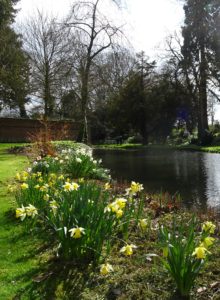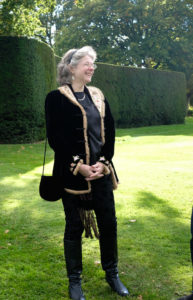Margery Fish (1892–1969)
Plantswoman and garden writer
‘Margery Fish, virtually single-handedly, was responsible for the renewed popularity of the ‘cottage garden’ style of planting in the second half of the twentieth century’ (Catherine Horwood).
Margery Fish (née Townsend) has a very tenuous link with Buckinghamshire: although she probably visited her family in Chalfont St Peter frequently, unfortunately there is little documented information about her early life to confirm this. While writing my MA dissertation I discovered that her family had lived round the corner from my subject Maud Grieve, the herbalist. There is also a link with Valerie Finnis who was a friend (they always referred to each other by their surnames) and one of the few people allowed to photograph her.
The Townsends were a Quaker family who had four daughters, Dora, Nina, Margery and Kathleen. Margery was born at Stamford Hill, London and educated at the Friends School in Saffron Walden and secretarial college. Once the girls had grown up the family moved to the relative quiet of the Buckinghamshire village, sometime towards the end of the First World War. The Townsends initially rented ‘The Spinney’ in Misbourne Avenue, while their new home, ‘Greenacres’ in Monument Lane to which they moved around 1920, was being built. Sadly, their mother Florence died in 1920 and their father Ernest, a tea importer, in 1926. Margery’s sisters remained in Chalfont; however, she was already working and probably living in London – it was becoming more acceptable for women to have their own lives and careers.
Dora continued to live at Greenacres and Nina married Francis Boyd-Carpenter whose mother lived next door at Cedars Cottage. Their son Henry eventually inherited Lambrook Manor, later selling it in 1985. Margery spent over 20 years working in Fleet Street, initially with countryside magazines and then with Associated Newspapers. There she accompanied Lord Northcliffe on a war mission to the United States in 1916, and then worked as secretary to six successive editors of the Daily Mail, the last of whom, the widower Walter Fish, she married on 2 March 1933, three years after his retirement. In 1937 they purchased East Lambrook Manor near Ilminster in Somerset for £1,000, settling there permanently two years later.
They immediately commenced work on restoring and creating the garden. Margery was a novice and initially relied on Walter for advice, as she had previously left the gardening to her sisters. She wanted to create an informal garden using cottage garden flowers, while also allowing for spreading and self-seeding of native plants. There was to be floral interest appearing all the year round. Her husband, on the other hand, preferred a more formal style with extravagant displays of summer flowers. The battle of wills between them was described in the first of her gardening books, We Made a Garden (1956), which is as much about a difficult marriage as about the difficulties of starting a garden from scratch.
Only after Walter’s death in 1947 could Margery fully implement her ideas and develop her skills as a plantswoman. She had a passion for unfashionable green hellebores and other shade-loving spring flowers: epimediums, primroses and snowdrops. She sought to make things grow in cracks and crevices. She soon had a group of correspondents, with whom she swapped ideas and rare plant material. These included Lawrence Johnston of Hidcote Manor, the garden designer Nancy Lindsay, and her neighbour Violet Clive of Brympton d’Evercy, an equally passionate gardener. By the late 1950s, East Lambrook garden was being opened to the public for charity and had a small plant nursery attached to it. In 1963 she received a silver Veitch Memorial Medal from the Royal Horticultural Society.
The garden at East Lambrook is on the Historic England Register of Parks and Gardens at Grade I and is well worth a visit.
https://historicengland.org.uk/listing/the-list/list-entry/1001247
https://en.wikipedia.org/wiki/Margery_Fish
http://www.eastlambrook.com/pages/site.php?pgid=1
Margery Fish’s Country Gardening, Timothy Clark (1989)
Gardening Women, Catherine Horwood (2010)
Claire de Carle, March 2021



